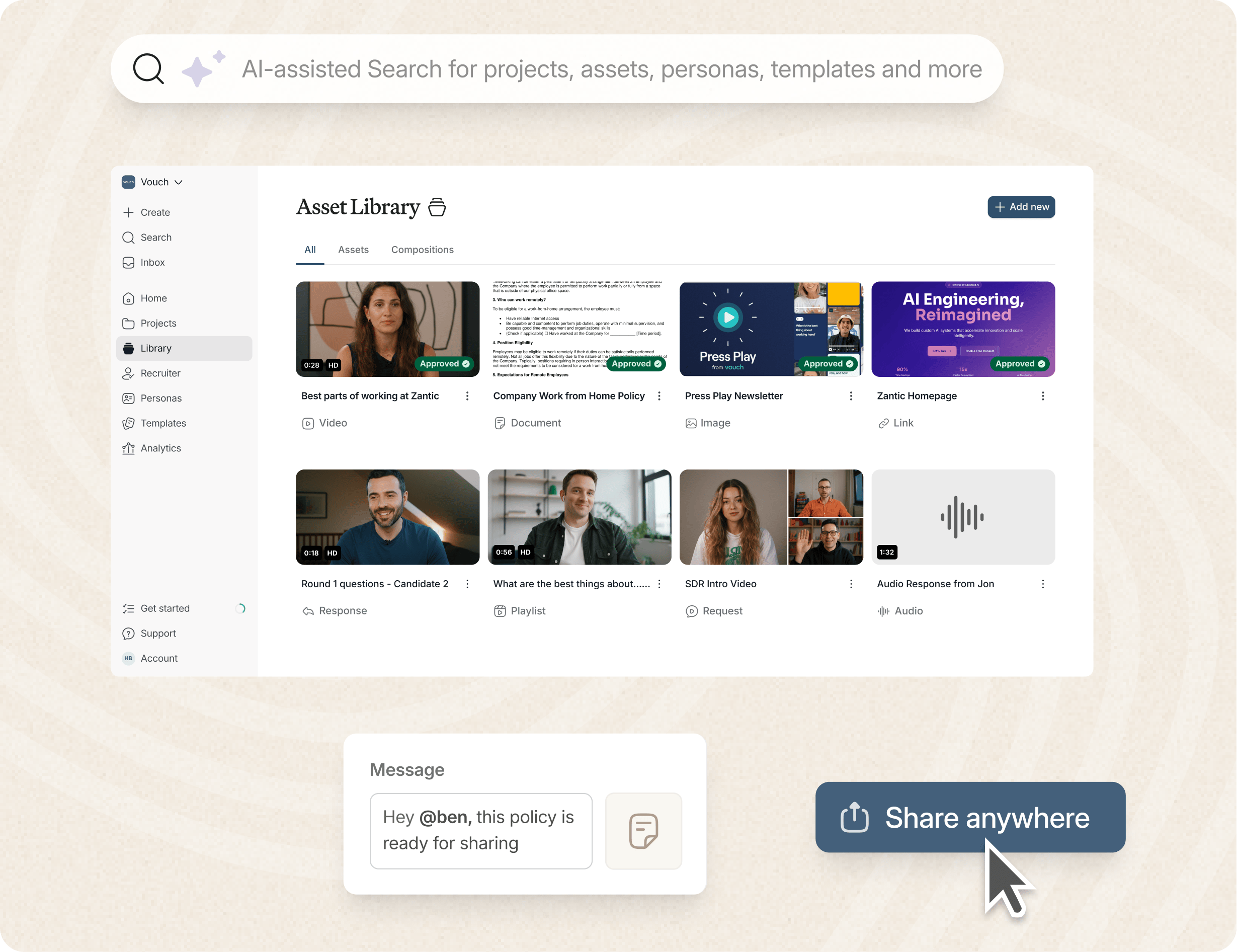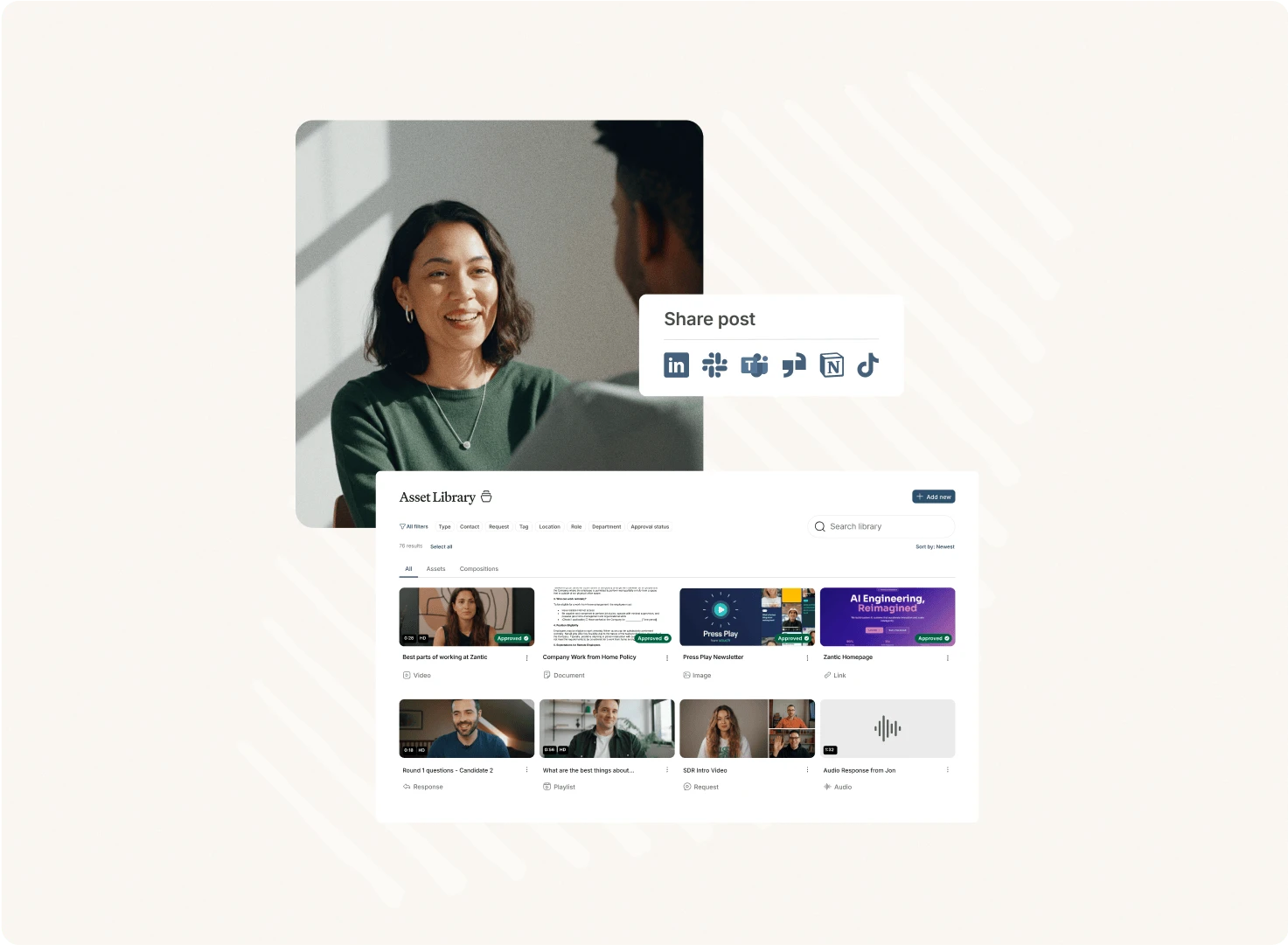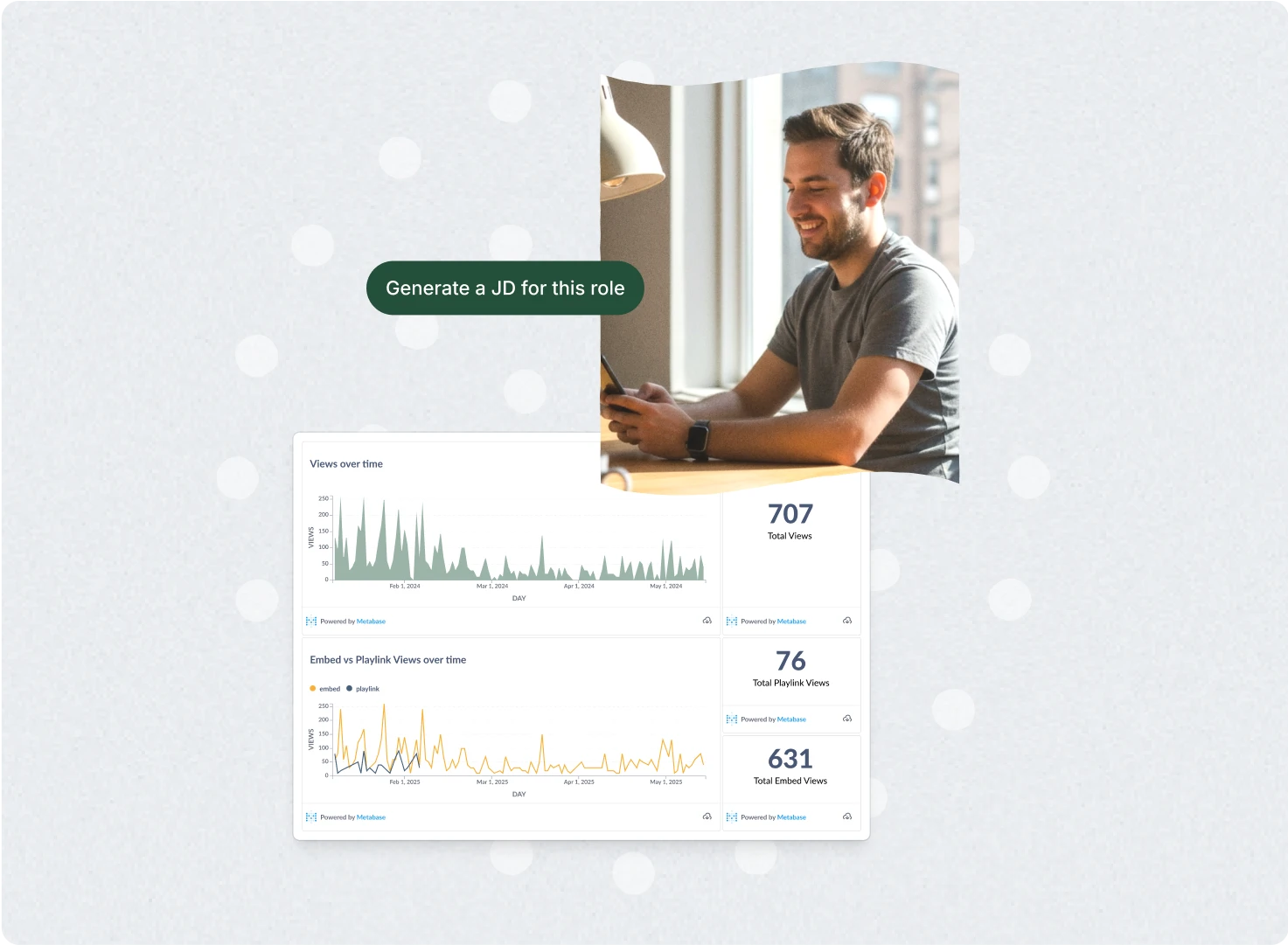Finding and selecting the right candidate for a job involves a multi-step process and, for most of us, lots of coffee.
From building a hiring plan to conducting interviews and sending offers, there are several essential steps to follow, that take time and energy.
However, once you have everything locked down, it's just a matter of minor refinements.
In this guide, we will walk you through the top 7 steps in the hiring process to ensure seamless talent acquisition and employee onboarding, along with looking at tools like Vouch video that make recruitment easier.
So, let's dive into the 7 must do hiring steps:
Step 1: Candidate Applications
Beyond advertising on job boards, social media, using agencies, etc, The application phase is the first step in the actual hiring process.
While it may seem passive, by utilizing a range of selection tools, such as qualifying questions and gamification techniques, you can effectively assess applicants' skills and qualifications in less time.
Qualifying Questions
One effective way to filter candidates is by incorporating qualifying questions into the application. These questions help ensure that applicants meet the minimum requirements for the position, saving time and effort for both the hiring team and the candidates.
This is also where one-way video interview questions can be remarkably helpful. They can speed up the initial screening phase and ensure that all candidates are given the same qualifying questions to remove biases.
Gamification Techniques
Gamification can enhance the application phase and make it more engaging for candidates. Employers can use interactive elements, such as quizzes, puzzles, or challenges, to assess applicants' skills and knowledge. This not only adds an element of fun to the process but also provides valuable insights into candidates' abilities.
Streamlining the Application Process
In order to minimize application abandonment rates, it's essential to keep the application process simple and user-friendly, which is why video interviews with tools like Vouch can be so powerful.
A complex application form or a lengthy process can deter candidates from completing their applications.
By making the application mobile-friendly and easy to navigate, using video, etc, employers can increase the likelihood of candidates completing the application process in minimal time.
Simplifying the application process can reduce application abandonment rates, ensure a smooth and efficient hiring process, and help remove time and stress for your hiring team.
The AI-enabled workspace for talent teams.
- Unified workspace for talent teams
- Accelerate hiring with AI tools
- Auto-generate polished hiring and employer brand content
- Easily repurpose assets across all channel

Step 2: Resume Screening
Once applications are received, the next step is to screen resumes and cover letters to narrow down the candidate pool.
This is one of the more involved jobs, and it is where coffee addictions can start.
Because during resume screening, it is crucial to carefully evaluate the resume layout and assess the information provided in the cover letter - it's a lot of reading and why lots of recruiters love Vouch. Video is just a lot easier to digest.
With video, you can also detect the intangibles, like soft skills, cultural match, and body language of candidates. It's also a nicer way for candidates to share their hobbies and interests beyond words on a page.
These intangibles can play a significant role in candidate selection - and that leads into the next steps in the hiring process.
Step 3: Pre-Employment Testing
Pre-employment testing is a critical step in the hiring process that sometimes gets missed.
By utilizing various tests, assessments, and leveraging tools like Vouch, you can effectively evaluate candidates' skills, cognitive abilities, and personalities to determine their suitability for the job - which is also key to retention.
Skills assessments help employers gauge the specific abilities and competencies that are required for the role, while cognitive ability tests are designed to measure candidates' cognitive aptitude, including their logical reasoning, critical thinking, and problem-solving skills.
These tests provide insights into an individual's ability to analyze information, make sound judgments, and adapt to new situations.
In addition to traditional tests, job simulations and work samples can be incorporated into the pre-employment testing process. Job simulations aim to replicate real-world work situations, allowing candidates to showcase their capabilities in practical scenarios.
Work samples, on the other hand, provide tangible evidence of a candidate's previous work and their ability to perform specific tasks relevant to the job.
Furthermore, pre-employment testing enables employers to identify candidates' strengths and areas for development, offering valuable insights for training and development programs once the candidate is hired.
Step 4: Interviews
We're at step 4, which is where most people who don't work in HR think hiring starts and ends. It's sometimes a shame that most people don't understand the full breadth of tasks and skills required by recruiters and talent acquisition teams.
Of course, this is where the candidate is really put through the paces. Interviews are significant as the step prior to selection, and there are a number of different recruitment styles, which we'll explore.
Types of Interviews
1. Structured Interviews:
These interviews follow a predetermined set of questions to ensure consistency and fairness in the assessment process.
2. Behavioral Interviews:
Behavioral interviews focus on past behavior as an indicator of future performance. Candidates are asked to provide specific examples from their previous experiences to evaluate their competency.
3. Panel Interviews:
In panel interviews, multiple interviewers from various departments or positions participate in the interview process, bringing different perspectives to the evaluation.
4. Virtual Interviews:
With the increasing use of technology, virtual interviews have gained popularity. These interviews are conducted remotely through video conferencing platforms, allowing flexibility for both employers and candidates.
Step 5: Reference Checks
Reference checks are an integral part of the hiring process, providing valuable insights into a candidate's past performance and overall suitability for the job.
By verifying the information provided by candidates and reaching out to their professional and character references, you can gather additional information that supports your hiring decisions.
When conducting reference checks, it is important to ask targeted questions that delve into the candidate's previous work experience, job responsibilities, and their working relationship with colleagues and supervisors. This allows you to gain a better understanding of their skills, abilities, and contributions in their previous roles.
By checking the credibility of the references, you can ensure the accuracy and reliability of the information you receive.
Character references can also shed light on the candidate's personal qualities, including their reliability, integrity, and interpersonal skills.
Tips for Effective Reference Checks:
- Prepare a list of targeted questions tailored to the candidate's job responsibilities and desired qualities.
- Contact references via phone or email to schedule a convenient time for the conversation.
- Ask open-ended questions that allow references to provide detailed information about the candidate.
- Request specific examples or anecdotes that illustrate the candidate's strengths and areas for improvement.
- Listen carefully to the references' responses and take note of any discrepancies or red flags.
- Follow up with additional questions if necessary to clarify any information that may be unclear.
Step 6: Background Checks
Conducting thorough background checks is an essential step in the hiring process. It helps ensure the integrity and reliability of candidates.
Employers must delve into various aspects to evaluate an applicant's suitability for a role, and you should never skip this step.
We should also mention, that when you make an offer and a candidate gets to this stage, be sure to have your next pick of candidates on hand. Sometimes, a background check will pull up data that you could not have foreseen.
Here are the checks to consider:
Criminal History
Checking criminal history is crucial to ensure the safety and security of your workplace. By conducting criminal background checks, you can identify any past convictions or legal issues that may impact a candidate's ability to perform the job responsibly and ethically.
Employment Verification
Verifying a candidate's employment history is vital in confirming the accuracy of the information provided on their resume. By contacting previous employers, you can validate their work experience, job responsibilities, and performance. This verification helps assess the candidate's suitability for the position and their credibility as a potential employee.
Education Verification
Education verification ensures that candidates possess the qualifications and degrees they claim to have earned. Verifying educational credentials provides crucial insight into an applicant's knowledge and expertise in their field. Contacting educational institutions can help confirm their attendance, graduation, and the authenticity of their academic achievements.
Credit Checks
Conducting credit checks can be relevant for certain roles, especially those that involve financial responsibilities or trustworthiness. These checks enable employers to evaluate a candidate's financial stability, responsibility, and potential risks they might bring to the organization.
Social Media Screening
Social media screening provides additional insights into an applicant's character and suitability for the role. By reviewing their online presence, you can assess their professionalism, communication skills, and behavior. However, it's important to approach social media screening ethically, respect privacy laws, and avoid any discriminatory practices.
By conducting comprehensive background checks, including criminal history, employment and education verification, credit checks, and social media screening, employers can make more informed hiring decisions and mitigate risks. Remember to follow applicable laws and regulations to ensure a fair and unbiased hiring process.
Step 7: Offer, PreBoarding & Onboarding
Once you have selected the ideal candidate, it's time to extend the job offer and initiate the preboarding and onboarding process.
This crucial step sets the stage for the new employee's successful integration into your organization.
Negotiating terms
Before finalizing the job offer, it's vital to engage in a negotiation process to ensure fair terms for both parties. This may involve discussions on compensation, benefits, and other mutually beneficial factors.
Preparing the offer letter
Once the negotiation is complete, it's time to draft the offer letter. This formal document outlines the details of the job offer, including the position, salary, start date, and any other relevant terms and conditions. It serves as a legally binding agreement between the employer and the new employee.
Providing a seamless onboarding experience
Effective employee onboarding is key to ensuring a smooth transition and successful integration.
By creating a structured and supportive onboarding program, you can help new hires feel welcome, acclimate to their roles, and understand the company culture.
This is also where video can be brilliant (be sure to check out Vouch). You can provide onboarding videos instead of long, lengthy documents that most people struggle to digest and remember.
Orientation and training programs
Dedicate time to orientation and training programs that equip new employees with the necessary knowledge and skills to excel in their roles. This includes providing an overview of company policies and procedures, introducing them to their team members, and offering specific job-related training.
Additional 2026 Strategies for Effective Hiring
In addition to the 7 steps mentioned, there are additional strategies that can enhance the hiring process. By implementing these strategies, organizations can source a wide range of qualified candidates and build a strong talent pipeline for future hiring needs. Here are some effective strategies to consider:
Proactive Candidate Sourcing:
Take a proactive approach to finding candidates by utilizing various channels such as employee referrals, job boards, and leveraging your Employer Brand for social media recruitment. Encourage your existing employees to refer potential candidates, as they can often provide valuable insights and connections.
Current Employee Referrals:
Tap into your employees' networks by incentivizing them to refer qualified candidates. Offering referral bonuses or recognition programs can motivate employees to help identify top talent.
Niche Job Boards:
Post job openings on popular job boards and niche platforms relevant to your industry. This can attract a diverse pool of candidates with specific skills and experience.
Social Media Recruitment:
Leverage the power of social media platforms such as LinkedIn, Facebook, and Twitter to promote job openings, connect with potential candidates, and showcase your organization's culture and values.
Building a Talent Pipeline:
Establish and maintain relationships with potential candidates who may not be immediately available but possess valuable skills and experience. By nurturing these relationships, you can create a pipeline of qualified candidates for future hiring needs.
By incorporating these additional strategies into your hiring process, you can widen your candidate pool, attract top talent, and ensure a continuous flow of qualified applicants. Taking a proactive approach is key.
Who Are The Top 10 Global Companies Who Are Known For Their Hiring Processes?
Here are 10 global companies that we believe have exceptional hiring processes, blending innovation, an amazing candidate experience, and inclusivity:
1. Apple
- Interview Experience: Highly rated for being respectful and conversational.
- Focus: Understanding candidate motivations and cultural alignment.
2. Google (Alphabet Inc.)
- Known For: Rigorous, data-driven hiring emphasizing innovation and problem-solving.
- Focus: Passion, potential, and cultural fit over pure experience.
3. Meta (Facebook)
- Innovation: AI-driven hiring process, especially in technical recruiting.
- Balance: Automation with a retained human-centric approach.
4. NVIDIA
- Approach: Intense technical interviews with strong emphasis on real-world problem-solving.
- Ideal For: Candidates with deep technical and creative skills.
5. Slack
- Unique Feature: No whiteboard interviews; inclusive and adaptable assessment processes.
- Candidate Experience: Transparent, accommodating, and collaborative.
6. Bain & Company
- Reputation: Regularly ranks as a top employer with a supportive, clear hiring journey.
- Focus: Long-term cultural alignment and leadership potential.
7. McKinsey & Company
- Structure: Up-or-out model, clear performance metrics, and structured onboarding.
- Process: Highly analytical and rigorous, including case studies and role simulations.
8. Cisco
- Culture: Employee well-being and community impact are central.
- Hiring Process: Focused on skills, collaboration, and fit within a global team.
9. Infosys
- Balance: Mix of internal promotions and external hires for specialty roles.
- Approach: Assessment-led, particularly for technical and consulting positions.
10. Menlo Innovations
- Unique Style: Collaborative “pair auditioning” where candidates solve real problems together.
- Philosophy: Culture-first hiring with a focus on team chemistry and values.
FAQs
What should employers do to streamline the application process?
Employers should keep the application process simple and mobile-friendly to reduce application abandonment rates. Leveraging modern tools like Vouch can also help speed up hiring and onboarding.
What does resume screening involve?
Resume screening involves considering background qualifications, assessing resume layout and cover letters, and being mindful of unconscious biases.
What types of tests can be used in pre-employment testing?
Various tests such as job simulations and work samples can provide valuable insights into candidates' potential performance.
How can employers ensure the accuracy of reference checks?
Employers can ask targeted questions and check the credibility of references to ensure the accuracy and reliability of the information.
How can social media be used in the background-checking process?
Social media screening can provide additional insights into applicants' character and suitability for the role.
What is the final step in the hiring process?
The final step is extending the job offer and facilitating the onboarding process for the selected candidate.
What is the importance of onboarding?
Onboarding helps new hires acclimate to their roles and foster a positive work environment.
Why is following a well-defined hiring process necessary?
Following a well-defined hiring process ensures successful talent acquisition and employee onboarding, leading to a seamless workflow and a productive workforce.
Conclusion
In conclusion, the recruitment process is a critical aspect of successful hiring and talent acquisition.
By following the 7 steps outlined in this guide, yourorganization can ensure a seamless workflow that results in the selection of the right candidates and enables effective employee onboarding.
Modern video tools like Vouch also make the recruitment process easier and can help your HR and talent acquisition teams across all stages of the recruitment funnel.
Simplify Your Hiring Steps With Vouch!
Loved by companies like Canva, Nike, Cisco, HubSpot, Amazon, and more, tools like Vouch make leveraging video in your business remarkably easy.
Be sure to book a Vouch demo today and chat with a video content expert.
You might also like

Elevate Your Brand Today With Vouch
Discover how Vouch can accelerate talent acquisition while helping you stay on-brand.






